Merida

By Jaimy de Vries
Merida is the capital of Mexico Yucetan. We loved this city. It has many beautiful colonial buildings and holds lots of history that goes back before Christ. This is THE place to learn more about the Mayan history and its development till the present day. And to visit Mayan ruins, like Chichen Itza and Uxmal.
We wanted a day in a city on the east side of the Yucetan Peninsula. There are many cenotes and Mayan ruins here. We were in doubt if we wanted to stay in Merida or Vallodid. We decided to go to Merida because we heard many good stories, there’s lots of culture in this town and from both places you can visit Chichen Itza – the famous Maya temple. From Isla Holbox we took an ADO bus that took approximately 5 hours.
Colorful city, colorful people
We loved this city. It’s rich of culture and is one of the safest cities in Mexico. We felt comfortable here, our home for a week. Merida has a big historic center with many cathedrals and churches. The buildings are all beautiful, some less maintained, but still an abended house looks really cool too. The city also had something romantic with its colonial buildings, palm trees and the kissing chairs you can see everywhere. It’s a photogenetic city. My favorite photo spots (and are surely worth a visit) are:
- Merida sign and Cathedral at Plaza de la Independencia
- Photo on a kissing chair, you spot them everywhere in the historic town
- Iglesia del Jesus
- El Pinar house
- Casa Azul
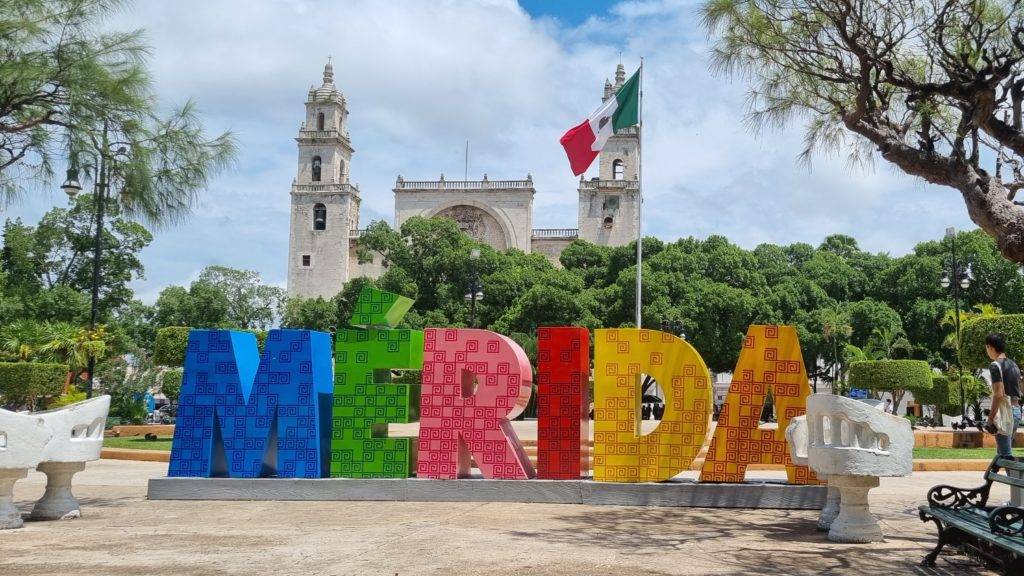
Merida sign at at Plaza de la Independencia
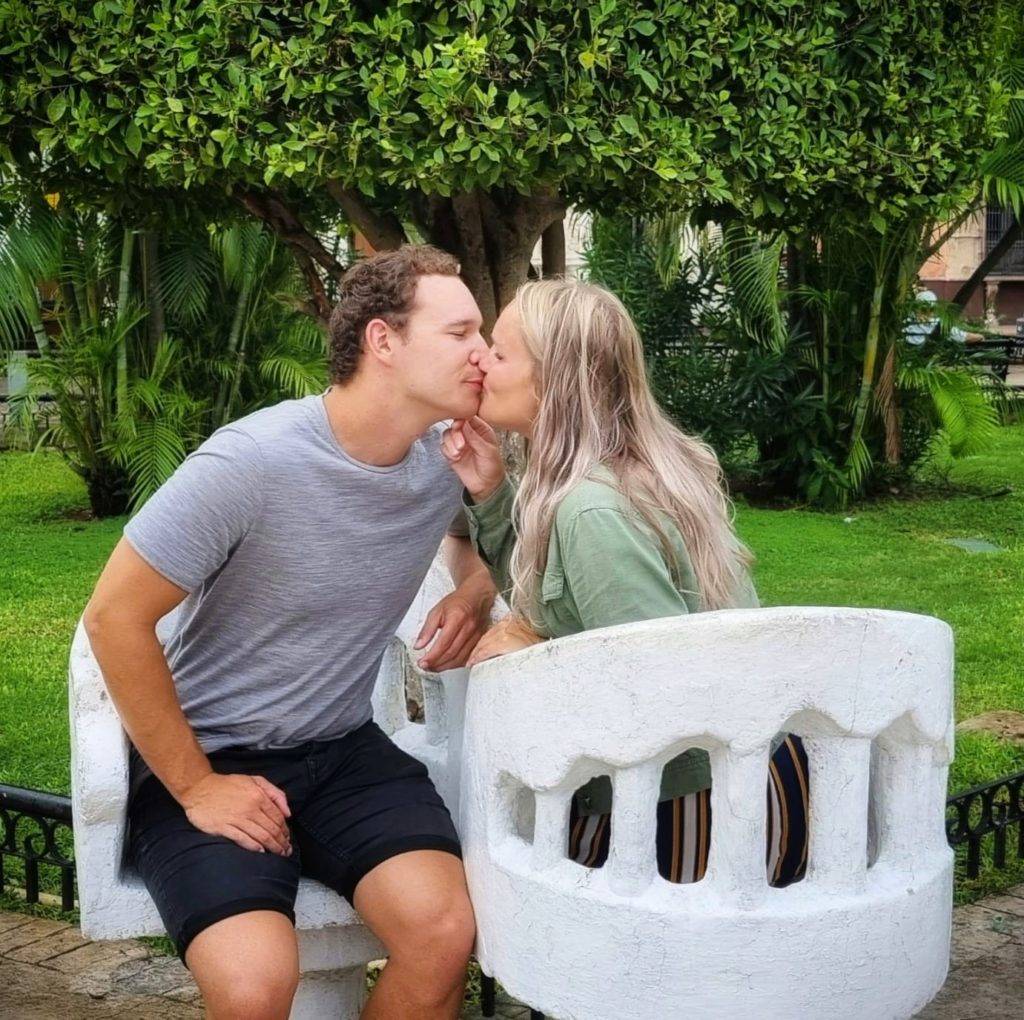
Kissing on a kissing chair
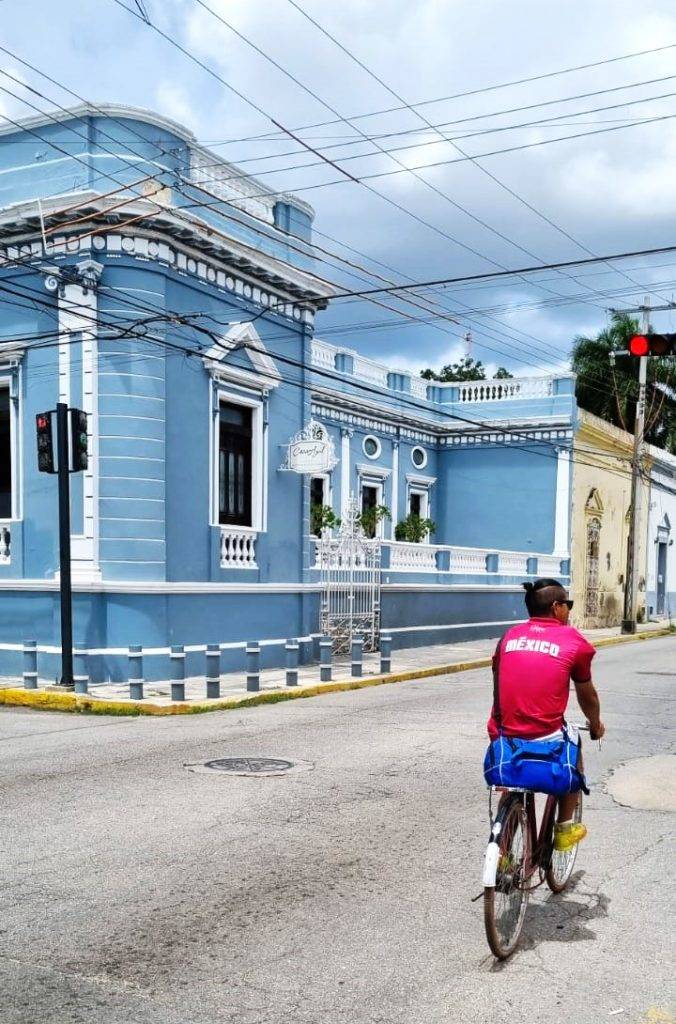
Casa Azul
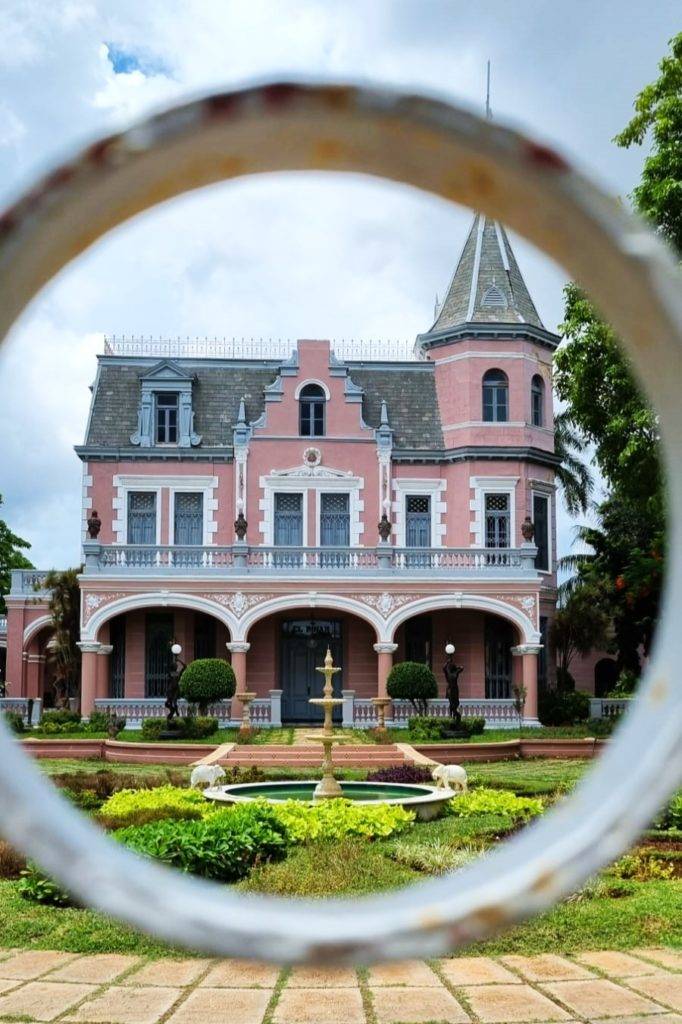
El pino house
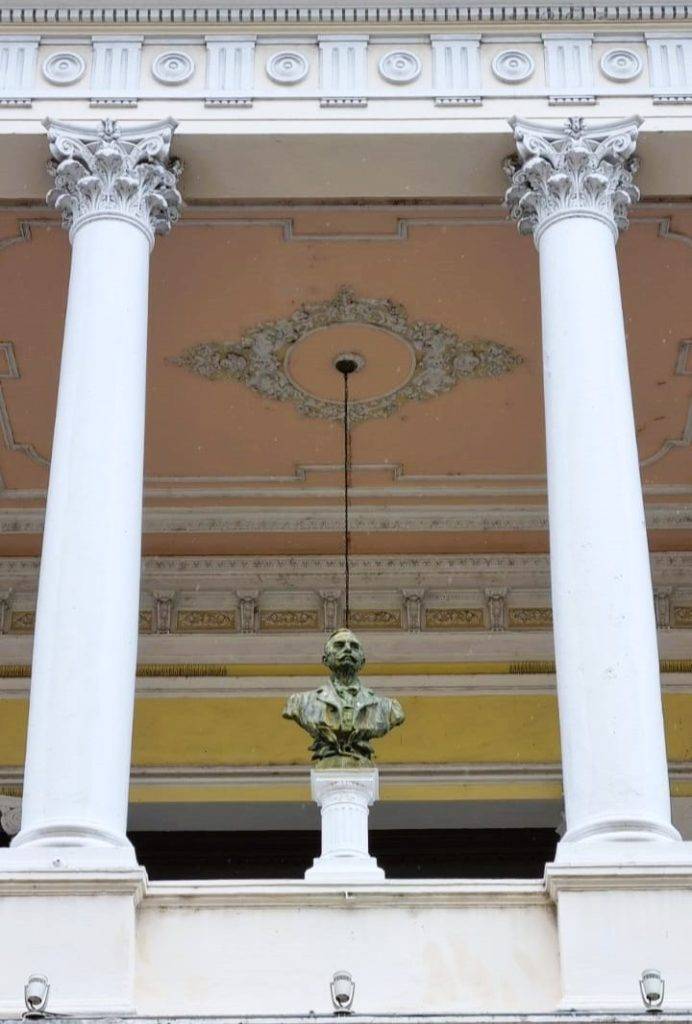
Statue at the theater
There’s a lot of life on the streets, not only pigeons, but many people walking and dancing on the streets. We saw people making music, yelling to sell their kiwi’s and people just want to make a conversation with you in the park to practice their English. We love the people here; they are kind, funny and hard working.
The city really comes to life on Sunday. The historic town is transformed into a bike city, they call it Biciruta. Roads are blocked for cars and only accessible by bike, skateboard and by running or walking. Everyone comes outside and participate in some physical activity. There are some bikes that you can use for free, or rent a bike for 20 mcx per hour. Everyone is happy, there is live music, good weather and lots of food and drink stands along the way. It was a great experience. Afterwards lots of people go for a drink or lunch at one of the many restaurants on the boulevard. This is such a great initiative of the government!
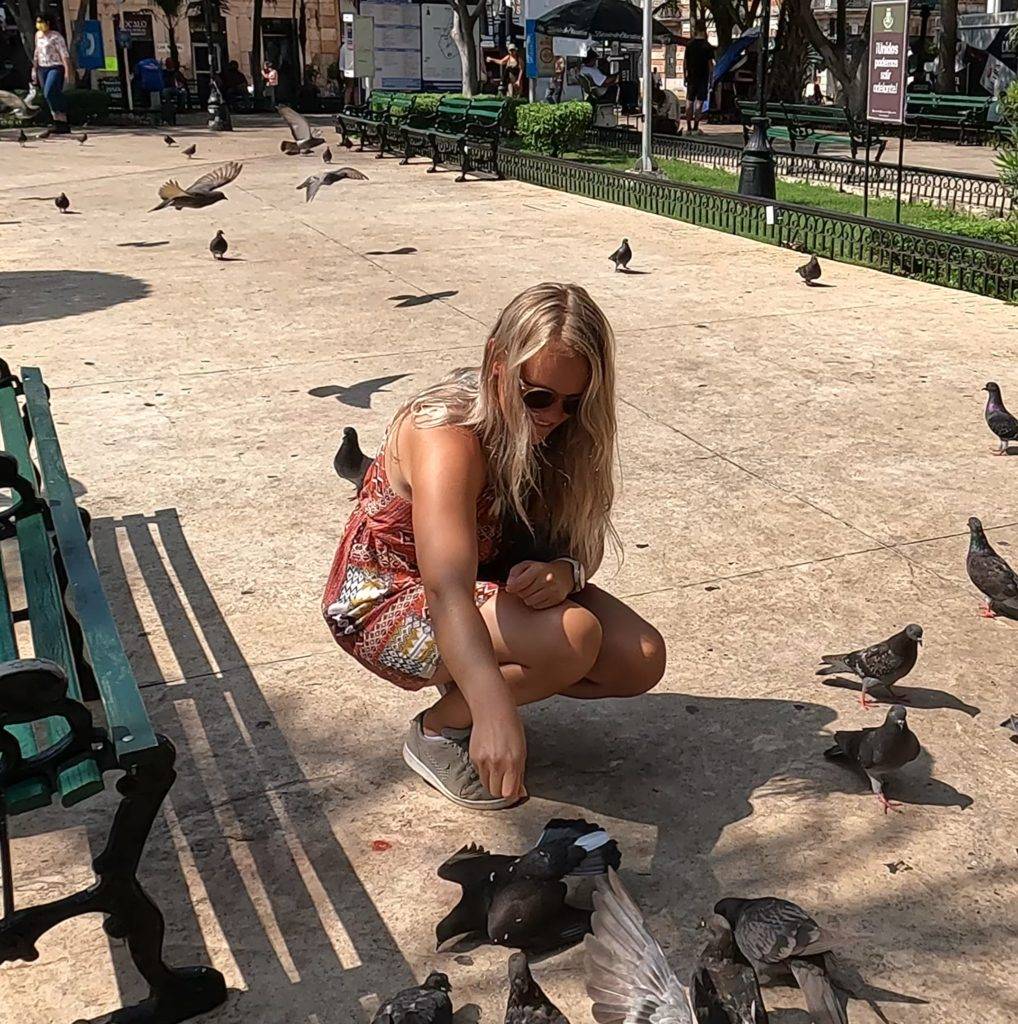
Feeding pigeons at the Plaza
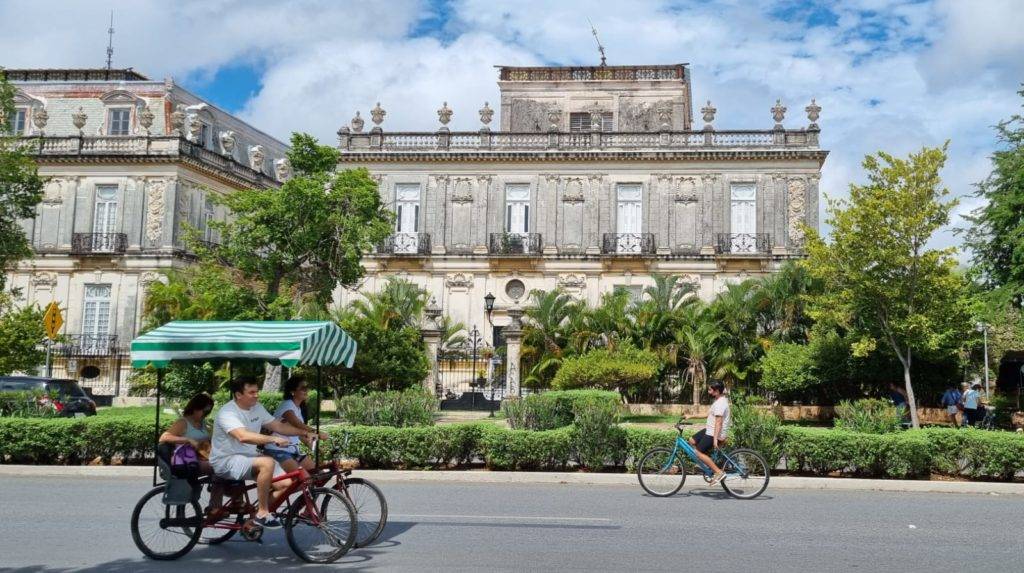
Lots of bikes on the boulevard at Biciruta day
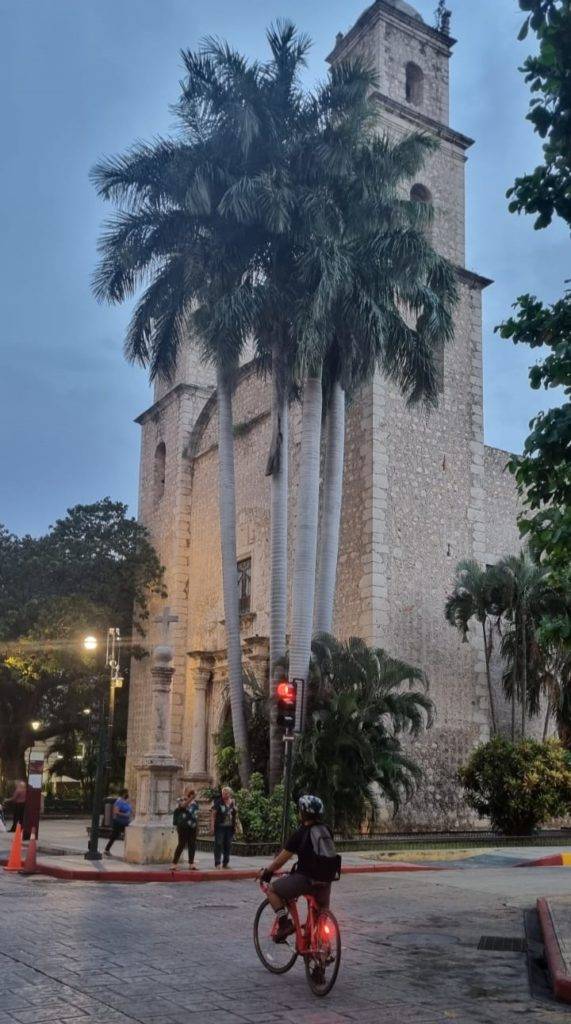
More bikers!
We also went to the market of San Benito Galvez Market Merida. I have seen some markets like this in Peru. This one looked quite organized and clean. I didn’t saw chicken feet hanging on a thread, big pieces of meat in the burning sun or something like that. But we saw a part of the market that sold animals. That was crazy. We saw chickens, birds, mice, guinea pigs locked up in one small cage. It looked so sad. This is definitely not something you’ll see in Europe (and glad it is).
History of Merida
Mérida has a rich Maya civilization history that predates the arrival of the Spanish by centuries. The city was built on the site of the ancient Maya city of T’hó, one of the oldest cities in the Americas. In 1542, Spanish conquerors founded and named the city Mérida after a Spanish city. In the early years, the Spanish established convents throughout the city to replace the indigenous culture with Christianity. By the end of the 16th century, much of the Maya culture and many of the Maya people were destroyed.
Like what the Spanish did in Peru with the Inca’s, is what they did here in Mexico. To build the city, the Spanish used many of the carved Maya stones to construct their colonial buildings, including many buildings found today in the historic center of the city, including the main cathedral. Limestone is predominately white, which gave rise to Mérida’s nickname: White City. Mérida was a walled city until the mid-19th century, built primarily to protect against periodic revolts by the indigenous Maya people.
After Mexico gained its independence from Spain in 1821, Yucatán became part of the Independent Mexican Empire in 1824. Today, Mérida is a thriving city of over 1 million people. It is the cultural and financial capital of the Yucatán Peninsula and often hosts international events. About 60 percent of Mérida’s population is of Maya heritage. The city also has many residents of Spanish, French and British ethnicity, making it one of the most ethnically diverse large cities in Mexico
Independencia de Mexico
The 16th of September is the celebration of the independence of Mexico. This day is an important celebration in Mexico, maybe even more in Yucatan where still many Mayan people live. The city organized many activities. Lucky for us they didn’t only celebrated it on the 16th, but they celebrated it a whole week in advance. The city organized many activities. Every day there was something to see. There was a lightshow every night at Palacio Municipal. And another amazing lightshow at the cathedral that presented the history of this city designed by locals. There were also dance shows with couples wearing typical Mexican clothing (white clothing with flowers). I was amazed by how quick they move their feet. But the most impressive show we saw was the PokTaPok game. This is an ancient ball game, actually the oldest ball game. With PokTaPok they try to get a heavy rubber ball through the ring. It sounds easy, but the ball is heavy, they need to get it through a high ring and… all that with their hips! After the game they put the ball on fire and throw it to each other and through the ring. Impressive!
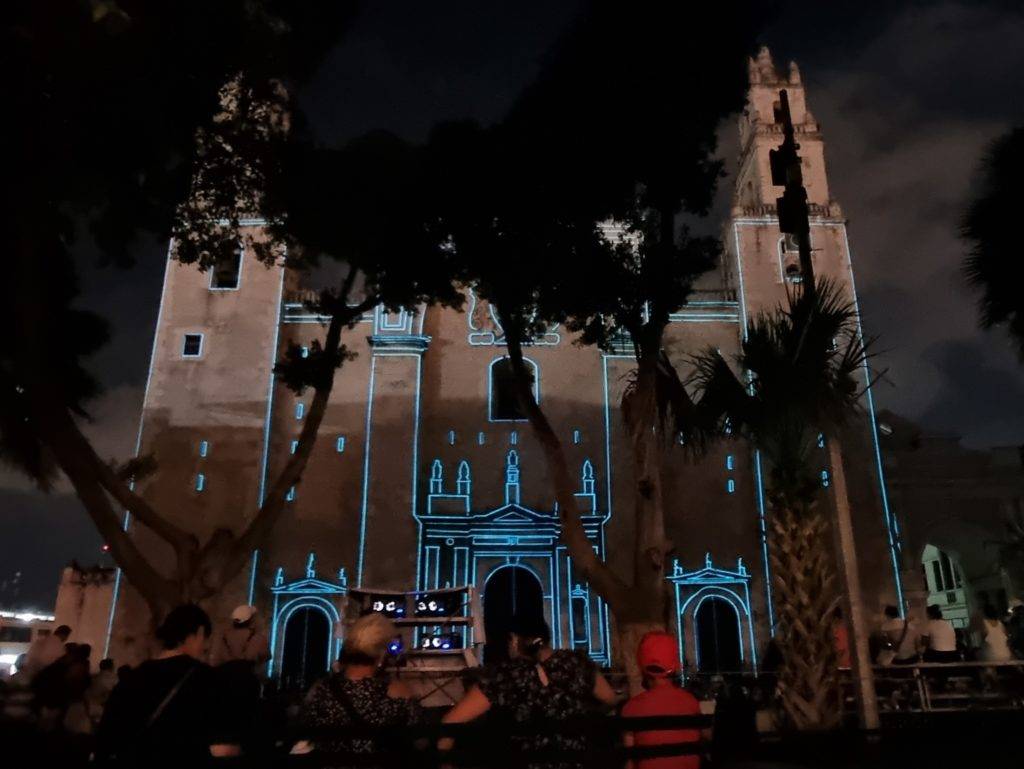
Lightshow on the Cathedral.
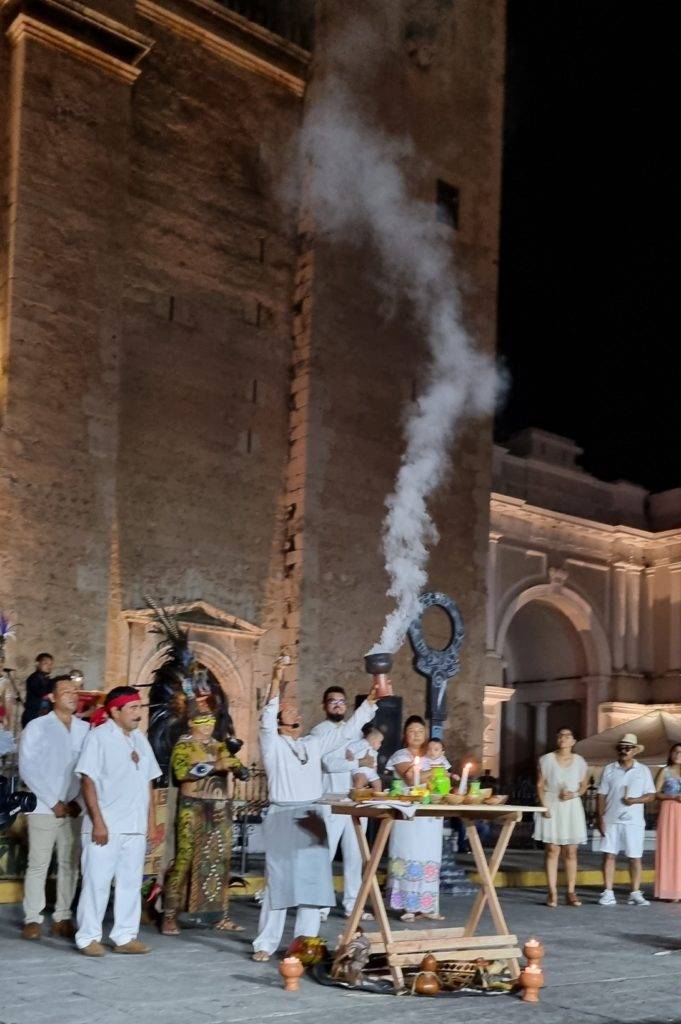
Mayan ritual at the Cathedral.
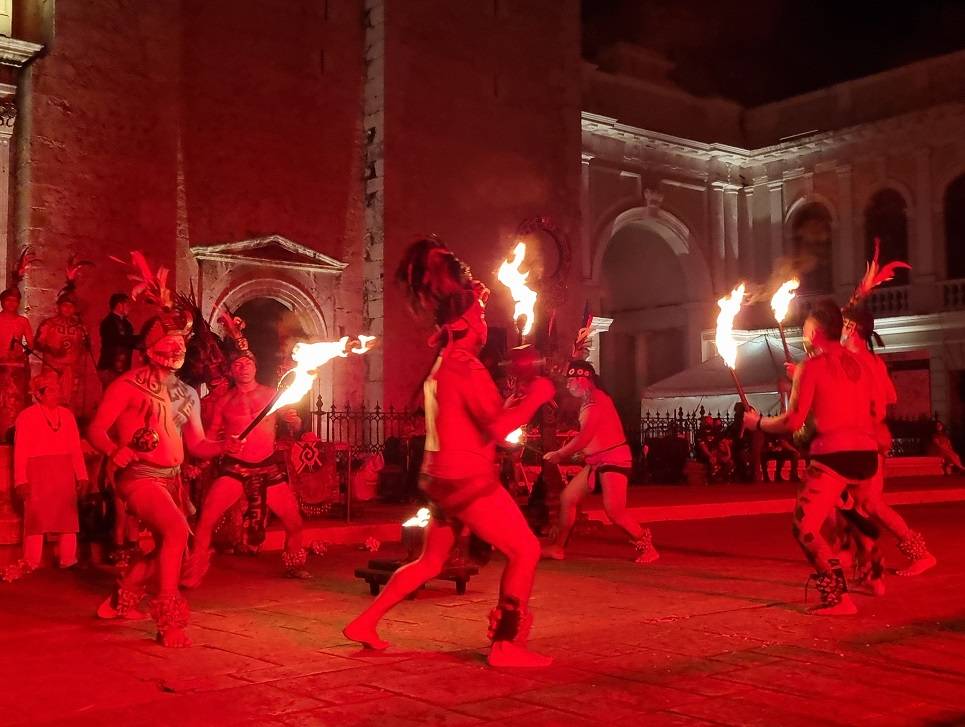
Ancient Mayan ballgame: PokTaPok in front of the Cathedral.
Day tours
From Merida there are many other places to visit, like the famous Chichen Itza and other Mayan ruins, cenotes, the pink lake at Los Colorados and some smaller villages. You can visit these places yourself by car or go on a day tour with a tour company. The tours are not expensive. They offer tours in packages, so you’ll visit more than one place. We got an offer for these packages for 800 MXN (= 40 euro). Normally it’s around 1000 MXN, but maybe because of lower season they offered it for a better price.
Here an example of the packages they offered:
- Izamal – Chichen Itza – Cenote Yokdzonoot – Vallodolid
- Cenote – Kabah – Uxmal – Museo del Cacao
- Los Colorados – Ria Lagartos – Playa Cancunito
Our Maya adventure
Merida is the city in Yucatan to learn more about the Mayan history and culture. The Maya’s are the oldest civilization and their ruins are a must to explore while you’re visiting Yucatan. There are people in Merida that are still speaking the old indigenous language. To learn more about the Maya’s we visited the Gran Museum Del Mundo Maya, enjoyed the festivals at the plaza and went on a tour to visit two Mayan ruins: Kabah and Uxmal. It was one of our favorited things to do in Mexico. I’m impressed by their lifestyle with so much respect for nature and animals. It also has something in common with other cultures, like the Inca’s.
To read more, click on the link below.
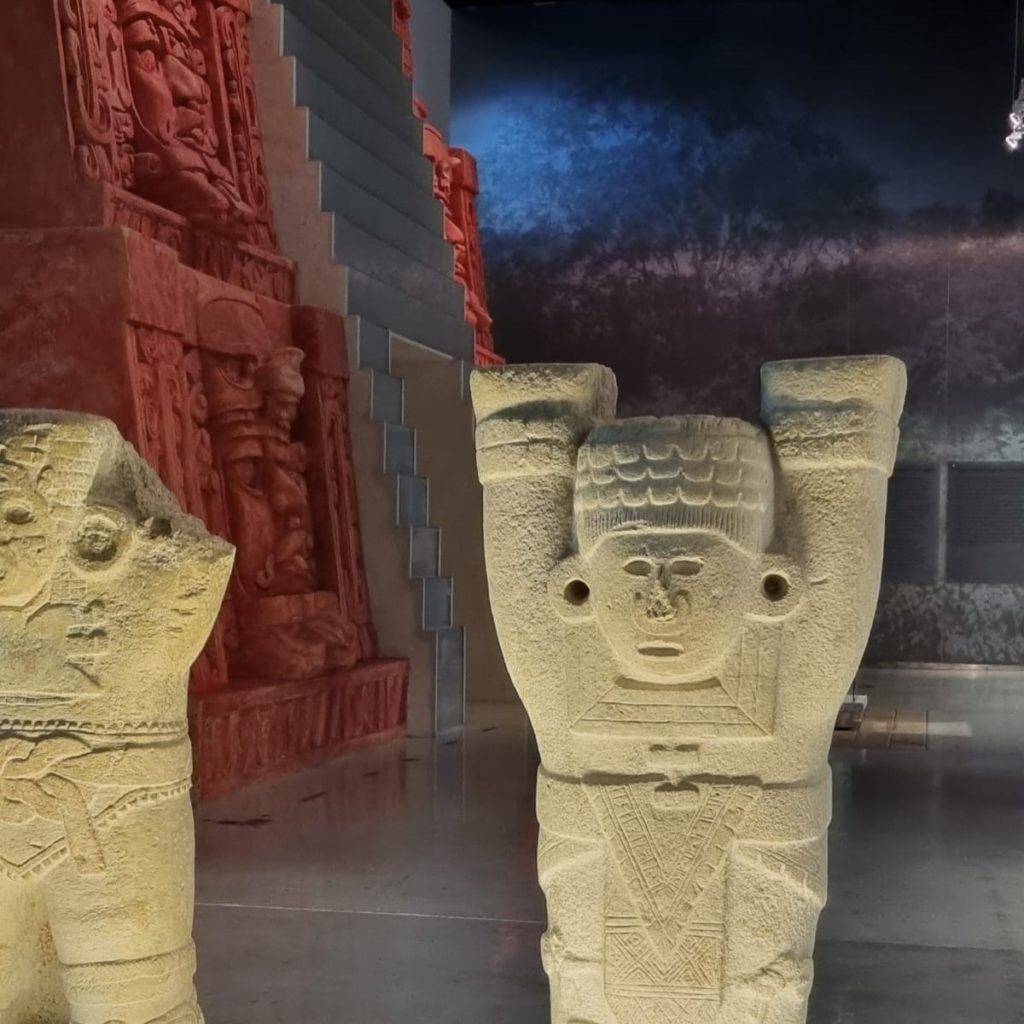
Rain season
Every day we were reminded it was rain season in Mexico. But mostly it was sunny and dry in the morning and beginning of the afternoon. At the end of the afternoon there were rain showers that could be short or could take several hours. The city sometimes turned into Venice, because of its many flooded streets. We were happy with our private room at a nice hotel with a swimming pool. When the sun was shinning we took our chance to enjoy the swimming pool and relax.
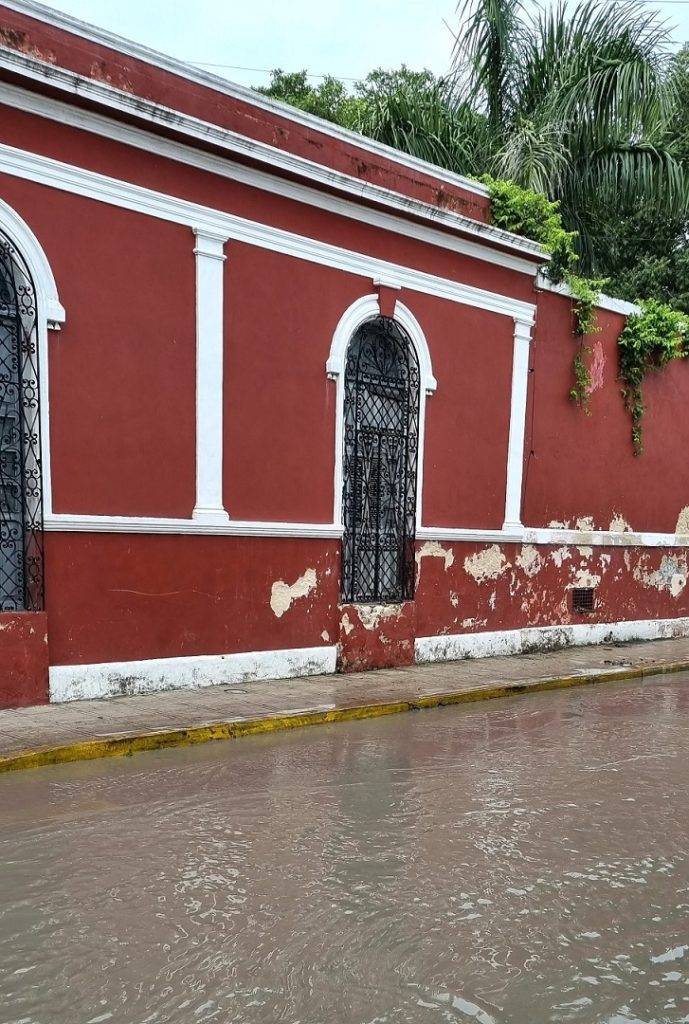
Flooded streets after rainfall
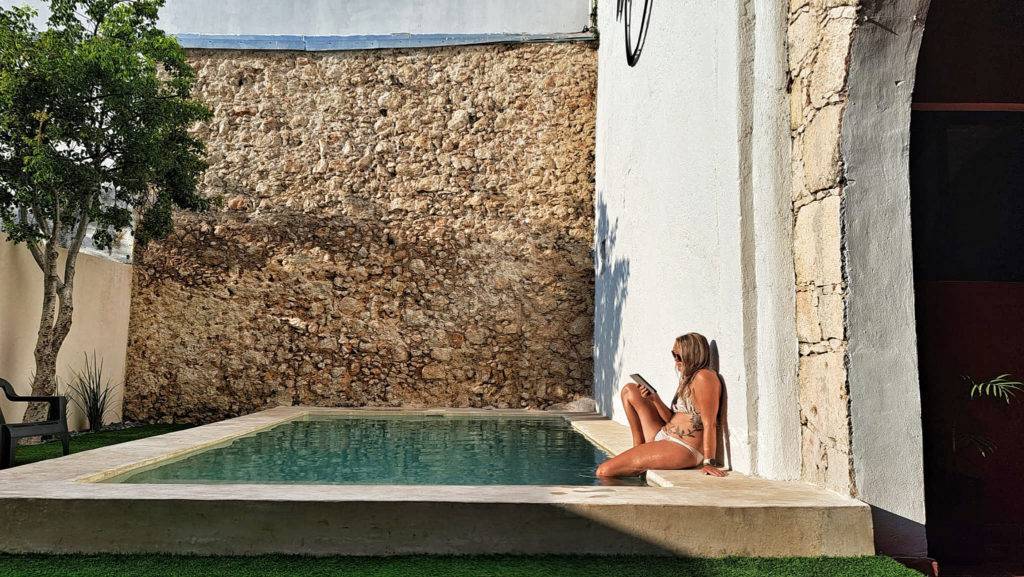
Chill at the swimming pool of our hotel.
My guide for your Merida trip
We stayed in Merida for one week and this was perfect! Here my recommendations:
- Recommended duration visit: 4-6 days
- Best places to eat: Trompos (our favorite) for cheap and good food.
- Favorite locals drinks: nice Mexican drinks are: Horchata (sweet milk drink, Jamaica (Hibiscus flower drink), of course tequila and Paloma (Tequila with orange juice).
- Highlighted things to do: biciruta on sunday, sunday market, nightlife at Santa Lucia Park, day tours to Mayan city (Chichen Itza or Uxmal), day tour to Los Colorados en Rio Lagartas
- Our accommodation: HO Merida hotel.
- My favorite activity: Daytour to Uxmal, cycling Biciruta.